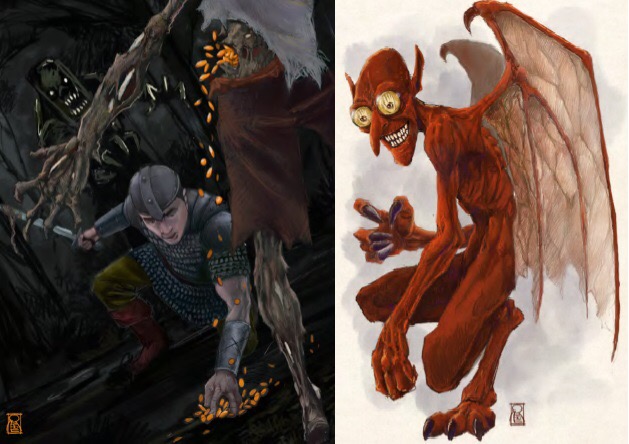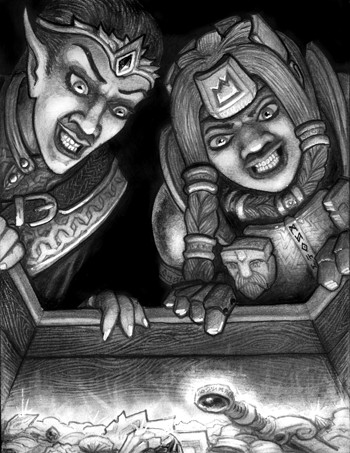Let me just begin with saying that this is a MASSIVE supplement. There is so much information and so many resources that can be pulled from this, it’s incredible. The page count is 162 pages which can seem somewhere in the middle but don’t look at the number, what’s actually written in this is the important part.
Gods and Icons is a supplement for 13th Age put out by John W.S. Marvin over at Dread Unicorn Games. Coming from a successful Kickstarter Campaign, I was interested in this from the start. As a disclaimer, it’s only fair to mention that John did send me a reviewer’s copy of the PDF to read for this website. As always, I will try my very best to be objective about the supplement and give you a clear idea of its strengths and weaknesses.
The first impression of the piece was good. The cover art isn’t the most attention grabbing to me, simply because I enjoy very realistic art. The art isn’t shabby or half-done throughout the book, it simply doesn’t always pertain to my tastes. That doesn’t mean I think it’s bad, because the art within is consistent with, and sometimes even better than the cover art. What’s notable about the art in particular is that there isn’t just people/icons/gods depicted in it. We get weapons, action shots and even religious symbols throughout the book. The variety of such is really nice and helps you sink into the setting that the author is trying to portray.
Moving on to the actual content, all I can immediately say is , “Wow.” There is so much to digest in this book. What surprised me is that yes, we get various gods and icons, but what’s not explicitly mentioned in the title, we get some new abilities for the druid, cleric, paladin and the much needed ranger. I was surprised to find these inside, considering I hadn’t done much research into the project beforehand due to some time constraints. With that we get some tips on how to use icon relationship points, random loot tables, random places to find loot tables, and even some tables on how the gods work with alignment in case you don’t want to read the whole section. That last one is really great because there is a lot of detail oriented information with the gods, which is the first section of the book. For a player looking at this book for the first time, that table will help you get an idea of what there is to be pulled from this, the basic flavor of it and then where to find it. It streamlines the process of finding exactly what you want beautifully.

Lady Akuma, one of the Icons presented in the piece.
The Gods themselves are split into three different pantheons (The Bright Gods, The Thirsty Gods and The Old Gods) with their own history of how they came to be worshiped and such. What’s nice about the pantheons is that the concepts of the gods/structure is familiar in a sense that they line up with historical religions. On the other hand, they’re unique enough to give you that fantasy essence that we all know and love. The elaborate stories and practices of their followers really helps bring them to life and would immensely help a player in role playing their devotion.
With the icons in the work, they also hold that “familiar but unique” sort of mindset. All of the icons coincide with a Dragon Empire (the base 13th Age setting) but are unique in their story, behavior and relationship with the gods presented in the first section. What I mean by this is that there are clear parallels to the Orc Lord, the Emperor, Archmage and so on. This makes it really easy for players and GMs alike to grasp on to these icons and use them, but are different enough to bring a different feel to the table. The added depth of relationship to specific gods brings a dimension to the setting that the Dragon Empire simply doesn’t have, though by design.
And then they went the extra mile. There is a wealth of magic items toward the back of this book that really surprised me. Not only does it encompass every type of magic item category, even wondrous items, but it also introduces some new magic items. Magical instruments, holy swords and a sacred branch reinforce the ideas of the gods put forth.

Slithik, a new playable race
Within all of this wonderful ammunition that the supplement gives you, there’s also some new playable races for your characters to mess around with. The one that resonated with me the most was the Dhampir, a half vampire type race. The rest, I probably wouldn’t use personally but the Half-owlbear and Hobgoblin are really awesome. That, yet again, is another personal preference, one that I tend to stick with races closer to humans because they’re easier to relate to and role play for me. Each new race is really unique in the way they work and your players that like playing weird and funky things will get a kick out of these.
One last thing of note that really grabbed my attention; NPC tables. There’s a random NPC generator built right into the book. It’s a random roll table that includes gender, race, personal quirks they could have and what icon they could be tied to. This is a really interesting idea and useful for either manually designing NPCs or using the table to randomly make one. Within the same vein of concept, at the end of the icons section of the book, there’s a random table for both agents of icons and iconic enemies. It’s useful in the same way as the former and really impressed me.
In conclusion, Gods and Icons is a very relevant supplement. It has some things that I likely won’t be using in the races section and some of the random magic items tables, but the flavor and overall setting of it is invaluable. If you’re looking for something new and refreshing but don’t have the time to manufacture your own setting, wipe out the flavor Dragon Empire and plop down the concepts presented onto the map!
Pick up the base book and the Players’ Companion here.
Stay Metal \m/





 Some of the evil Icons have some more dark and macabre items associated with them, which is something that really does call to me and my style of GMing/gaming. The Unyielding Plate in the Crusader section is really awesome for a heroic character, and slightly morbid for someone who identifies with the Icon. It should go without saying, but you need not have an association with an Icon to choose one of their items from the Book of Loot. Unless, of course, the item itself is tied to that Icon in its’ description. Such are rare cases, but I believe that the point of classifying the items into Icon categories was to give the player or GM some serious inspiration to give the item a story. In my experience, this has worked insanely well.
Some of the evil Icons have some more dark and macabre items associated with them, which is something that really does call to me and my style of GMing/gaming. The Unyielding Plate in the Crusader section is really awesome for a heroic character, and slightly morbid for someone who identifies with the Icon. It should go without saying, but you need not have an association with an Icon to choose one of their items from the Book of Loot. Unless, of course, the item itself is tied to that Icon in its’ description. Such are rare cases, but I believe that the point of classifying the items into Icon categories was to give the player or GM some serious inspiration to give the item a story. In my experience, this has worked insanely well.

